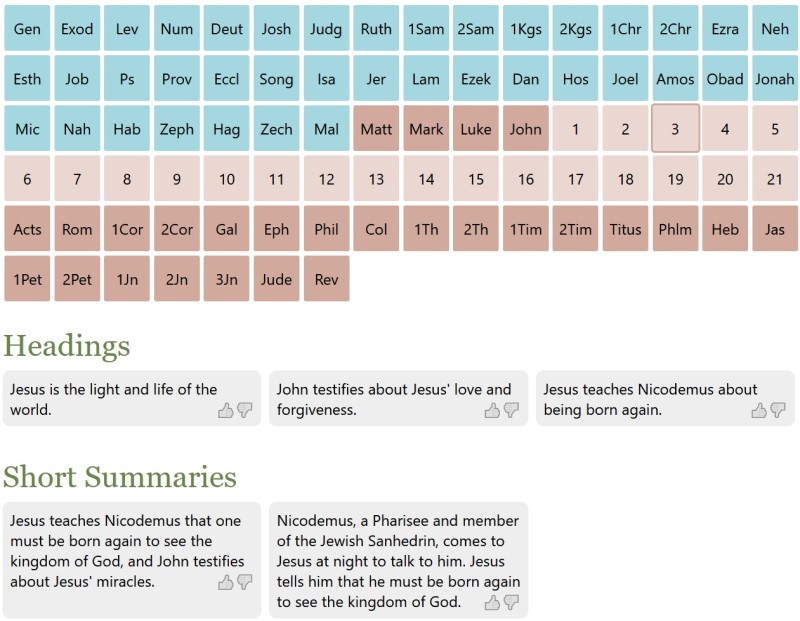AI-Assisted Bible Study is a new project that explores one way to apply an AI to personal Bible study, with AI-generated questions and prayers that apply to each chapter of the Bible. It helps you explore questions you might not otherwise ask, like “How have I let my livestock get in the way of my relationship with God?”

What This Project Does
This project presents AI-generated content for each chapter of the Bible in eight categories: headings, summaries, prayers, journal prompts, and application, exegetical, observational, and discussion questions.
For example, here’s sample AI-generated content for John 3:
- Heading: Jesus is the light and life of the world.
- Summary: Nicodemus, a Pharisee and member of the Jewish Sanhedrin, comes to Jesus at night to talk to him. Jesus tells him that he must be born again to see the kingdom of God.
- Prayer: Father, we pray that we would have hearts like Nicodemus, that we would be willing to learn from Jesus.
- Journal prompt: What do you think it means that Jesus said we must be born again?
- Application question: What does it mean that “whoever does not believe stands condemned already” in John 3:18?
- Exegetical question: What did Nicodemus misunderstand about being born again?
- Observation question: What did Jesus tell Nicodemus he must do in order to see the kingdom of God in John 3:3?
- Group discussion question: What did Jesus mean when He said that He must be “lifted up”? (John 3:14)
You can vote on content you find helpful or unhelpful. (I’m particularly proud of the CSS that handles the voting, which uses emojis as interface elements and doesn’t require any images. I’m also proud of the navigation, providing fast and compact access to any chapter in the Bible.)
How It Works
I prompted GPT-3 to generate text for each chapter in the Bible in each category. For example, the prompt to generate a prayer was:
Write 5 prayers inspired by John 3 in the Bible. Remember that the events described here are in the past. First include a short observation or lesson for each prayer, and then write a personal prayer related to the lesson.
I reviewed the generated text to avoid (or at least minimize) unhelpful or heretical content. I accepted about 90% of GPT-3’s suggestions on its first pass and regenerated the rest until it gave me something useful. It cost about $150 over six weeks to generate this content, which consists of 71,062 generations and 1.1 million words.
How It Doesn’t Work
Much of the content is useful—about the level you’d find in a typical group Bible study, with interesting insights mixed with odd and irrelevant content. When the content fails, it fails in four main ways:
- Heretical. This is the most severe category, which I tried most to eliminate. For example: “Help me to be like Judas and have the courage to betray Jesus when the time comes” or “What would it be like to be worshipped as a god?”
- Wrong. This is the hardest category to edit at scale. It includes factual errors (“David is forgiven, and Bathsheba’s son is healed,” “After Paul makes his defense, Agrippa finds him not guilty, but the Jews disagree and appeal to Caesar”) but also harder-to-discern, subtler errors like “What can we learn from Nahum 2:15-16 about God’s wrath?” (Nahum 2 only has 13 verses). Since I didn’t validate every reference, I expect that this category represents the bulk of unhelpful content. The project’s voting mechanism hopefully allows the helpful content to rise to the top over time.
- Confusing or very specific: “David rescues his family from Soup,” “How can I identify when someone is trying to lead a rebellion against me?” or the aforementioned “How have I let my livestock get in the way of my relationship with God?” It also likes to generate prayers for historical events as though they’re ongoing: “God, we pray for our leaders, that they would have wisdom to know what to do with the Book of the Law once it is found.”
- Vague: “What does Amos 3 reveal to us about God’s character?” or “What are the main points of Amos 5?” This content isn’t bad; it just doesn’t apply specifically to the passage.
Future
In theory, GPT-3 could also generate on-demand answers to the questions it asks about each passage. Doing so would require giving visitors access to the AI, however, which (per OpenAI’s requirements) requires that I create a login system—not something I’m excited to do.
It could also create content at a smaller unit than a chapter (such as a verse or section). In my tests, the content it generated often proved superior to full-chapter content, but going smaller would’ve ballooned the costs of this project.
Background
In my last post about AI-generated Bible art, I mused how the text- and image-generating AIs were doing most of the creative work, and I was just copy-pasting between them. That’s true, but in a larger sense, the AIs are allowing me to explore a possibility space faster and further than I would be able to on my own. As David Holz, the founder of Midjourney (another AI-powered text-to-image generator), says:
“It’s important that we don’t think of this as an AI ‘artist.’ We think of it more like using AI to augment our imagination. It’s not necessarily about art but about imagining. We are asking, ‘what if.’ The AI sort of increases the power of our imagination.”
Thinking of AI as an “imagination augmenter” captures that it’s not “creating” in the strictest sense but rather augmenting humans, allowing them to create at a speed and scale that wouldn’t otherwise be possible individually.
Therefore, this project tries to augment your imagination in your own Bible study.
Try out AI-Assisted Bible Study.